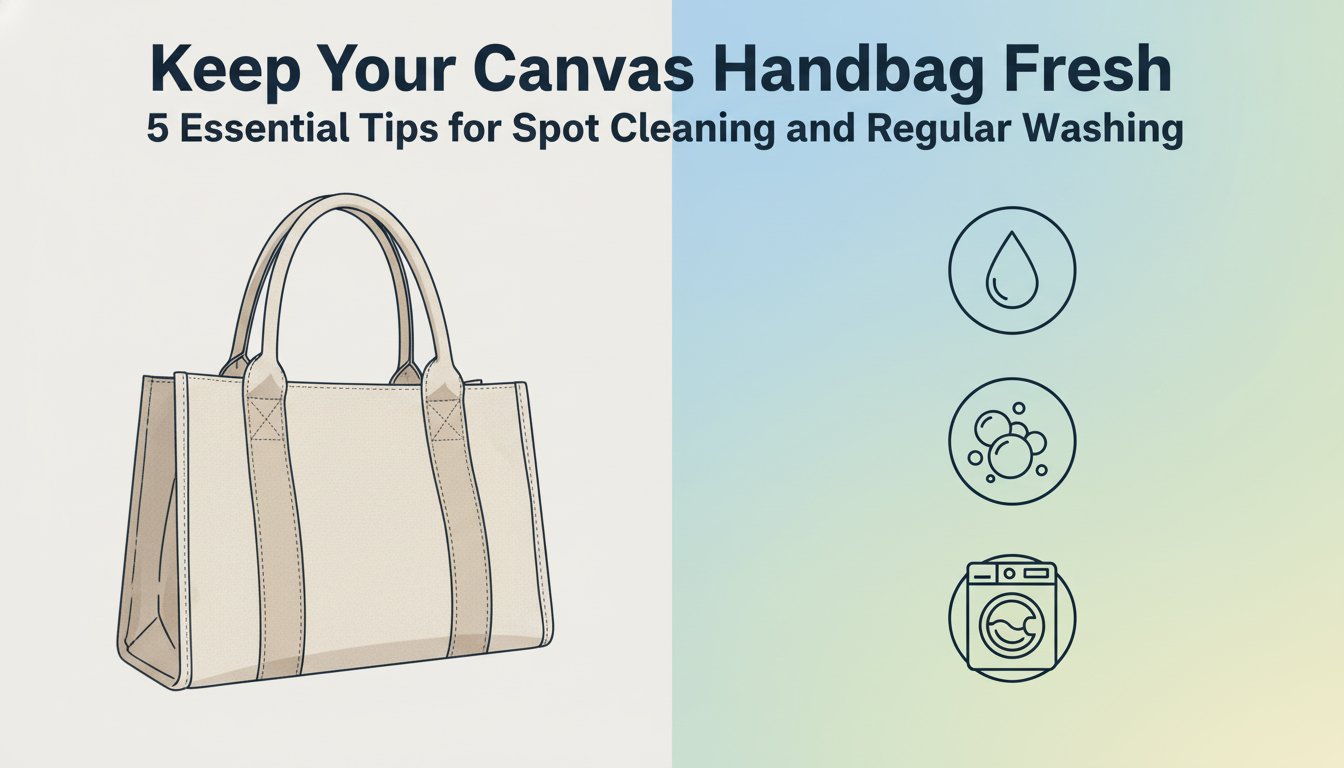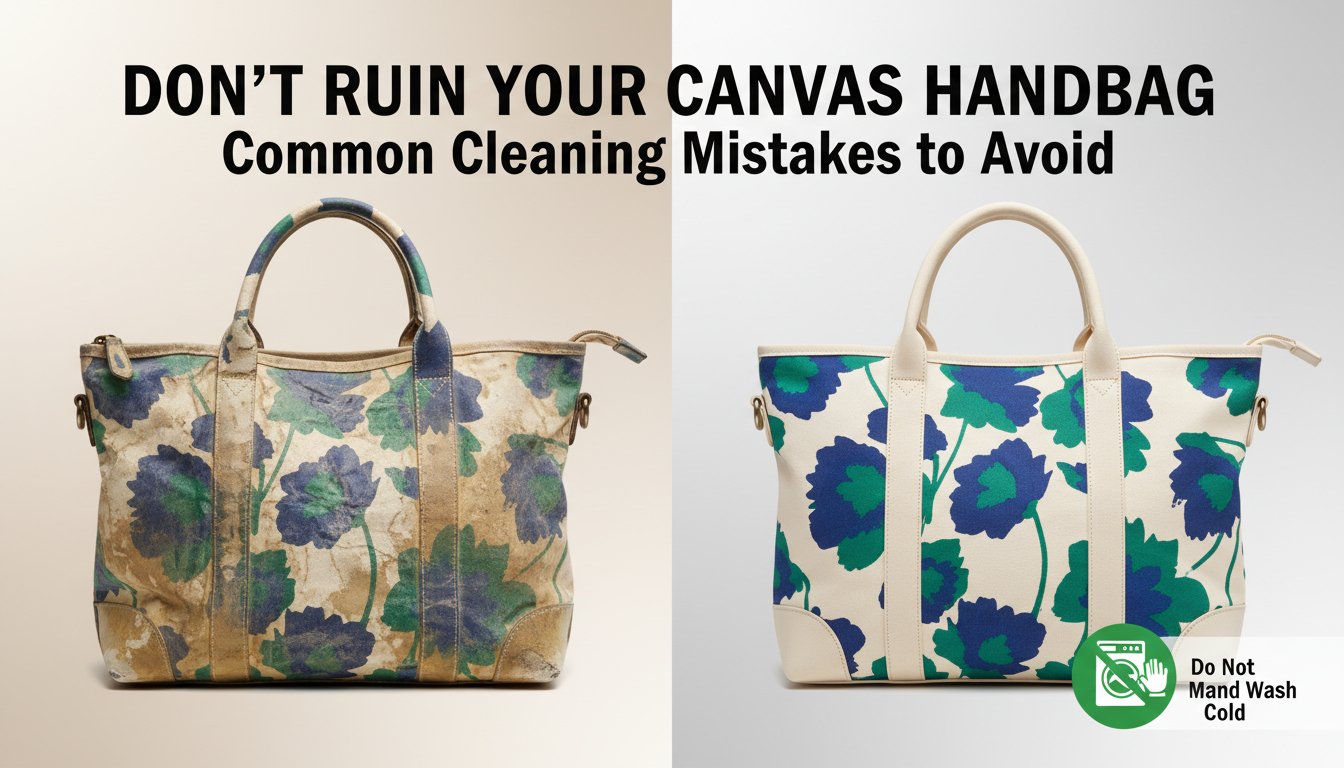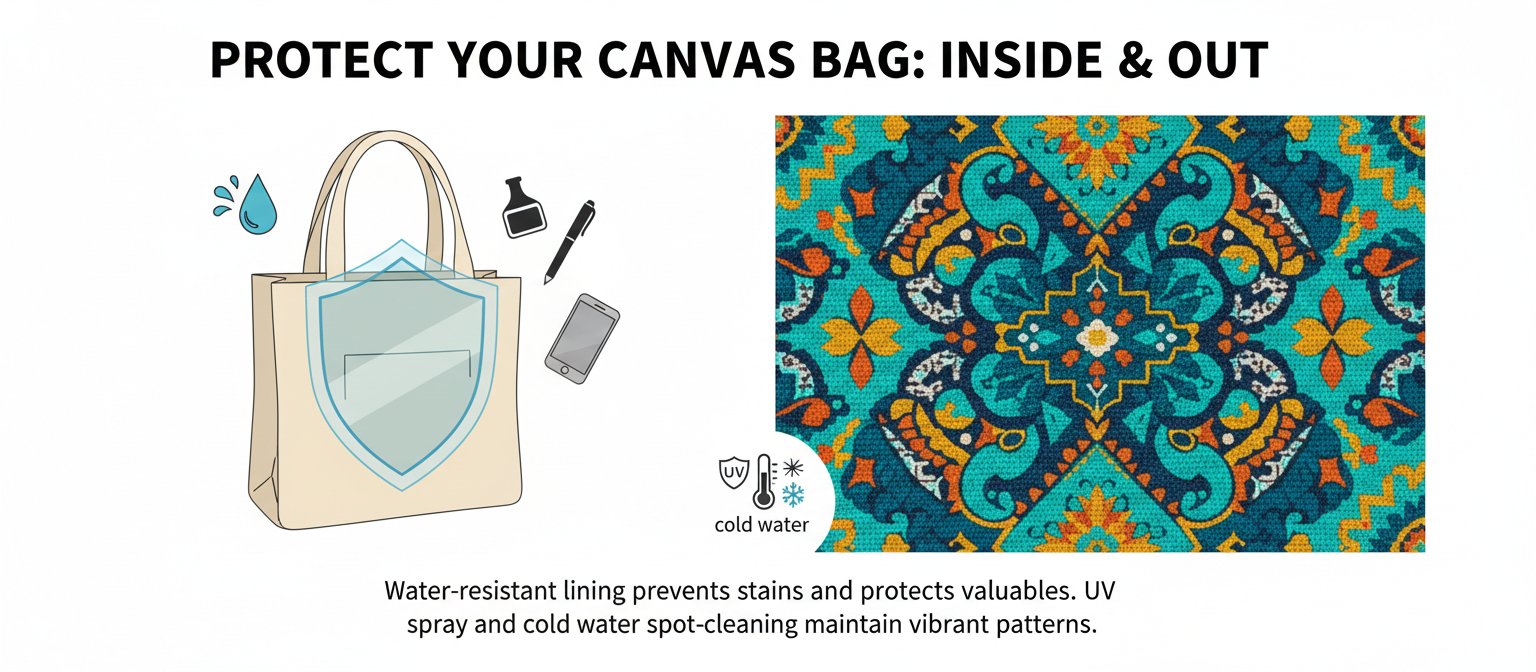How To Clean Canvas Handbag
Canvas handbag looking like it just survived a spaghetti storm? Or maybe your canvas bag’s once-vivid logo now resembles a faded ghost of branding past? We’ve all been there—coffee spills, makeup smudges, and mystery stains that show up uninvited. For businesses dealing in custom cosmetic bags, keeping them fresh isn’t just about cleanliness—it’s about protecting your brand’s vibe.
I remember watching my friend scrub her organic cotton tote with dish soap and sheer panic. That poor thing shrank two sizes and ended up looking like it belonged to a doll. Turns out, canvas needs more TLC than most folks think—especially when it’s got delicate prints or embroidery screaming for gentle handling.
According to Grand View Research, the global eco-friendly bags market is set to hit $10.3 billion by 2025—with canvas leading the charge thanks to its reusability and charm. So yes, how you clean these beauties absolutely matters.
Stick around—we’re talking tricks of the trade: cleaning without wrecking shape, saving those custom designs from doom, and making sure every bag leaves as good an impression as your pitch deck.
Quick Answers for a Cleaner Canvas Handbag
➔ Start With the Right Tools: Use mild detergent, soft brushes, and white cloths to protect both organic cotton and waterproof canvas.
➔ Test Before You Treat: Always spot-test cleaning solutions on hidden fabric areas to avoid discoloration or damage.
➔ Know Your Canvas Type: Organic cotton bags can be hand washed gently; waterproof canvas should never be soaked—just surface cleaned.
➔ Air-Dry With Care: Lay your large capacity bags flat in shade to maintain their shape and avoid fabric shrinkage.
➔ Handle Stains Gently: Spot clean sturdy handles with a damp cloth and soap instead of aggressive scrubbing.
➔ Wash Totes Regularly: Machine wash tote-style canvas bags using cold water and gentle cycles for long-term freshness.
➔ Protect Custom Designs: Avoid bleach or abrasive cleaners that could fade embroidered logos or printed patterns.
Guide To Cleaning Your Canvas Handbag
Cleaning your favorite canvas handbag doesn’t need to be a mystery. Here’s how to keep it fresh, spotless, and long-lasting without wrecking the fabric.
Gather Necessary Supplies for Cleaning Canvas Handbags
Before you start scrubbing, make sure you’ve got these essentials lined up:
- Mild detergent – No bleach or harsh chemicals; just something gentle enough for fabric care.
- A couple of soft cloths – White ones are best so they don’t transfer color.
- A small soft brush – Think old toothbrush or a soft-bristle shoe brush; helps lift dirt from textured areas.
- Clean water – Lukewarm is ideal; too hot can shrink cotton fibers.
- Optional: Fabric-safe stain remover – For stubborn spots that soap alone won’t tackle.
Prepping with the right tools makes cleaning your canvas bag way easier—and safer for the material.
Spot-Test Cleaning Solutions on Cotton Canvas
Always do a quick patch test before going all in:
• Pick a hidden corner inside your cotton canvas bag—like under a flap or inner seam.
• Dab your chosen cleaning solution onto the area using a clean white cloth.
• Wait about ten minutes and check if there’s any discoloration, fading, or weird texture changes.
If everything looks good? You’re clear to proceed with full cleaning. If not, switch out your cleaner—it could damage the fabric or mess with its colorfastness, especially in dyed canvas styles.
How to Clean Waterproof Canvas vs. Organic Cotton Handbags
Different materials call for different cleaning moves:
🟢 For waterproof canvas, stick with surface-only methods:
- Use a damp cloth and mild soap.
- Avoid soaking—it ruins the water-repellent finish.
- Skip abrasive brushes that might scratch protective coatings.
🟤 For organic cotton handbags, go gentler:
- Spot clean with diluted detergent and soft brush strokes.
- Rinse lightly but avoid drenching it.
- Let it air dry completely before storing.
Treat each type of canvas bag like its own personality—what works on one might wreck another.
Proper Drying Techniques for Large Capacity Bags
Drying matters more than you’d think when you’re dealing with big totes or weekender-style bags:
• After cleaning, gently press out excess water using a towel—don’t wring it! That distorts shape fast.
• Reshape by stuffing the inside with clean paper towels or even rolled-up shirts to help retain form during drying.
• Always air-dry in open shade—not direct sun—to prevent faded patches and preserve stitching strength over time.
Letting large handbags dry flat can also help maintain their structure without sagging at the seams—a little effort goes a long way here!
Five Tips For Maintaining Your Canvas Handbag’s Freshness
Keeping your favorite canvas handbag looking fresh doesn’t take a miracle—just a few smart habits. Here’s how to keep it clean, stylish, and long-lasting.
3 Essential Tips for Spot Cleaning Sturdy Handles
Your bag’s handles take most of the beating. Grime builds up fast, especially on light-colored ones. To keep those sturdy handles clean without damaging the fabric:
- Use a soft microfiber cloth dampened with water—not soaked.
- Add a drop of mild soap like Castile or baby shampoo.
- Gently scrub the affected area using circular motions.
- Rinse with another damp cloth, then blot dry with a towel.
- Let it air dry completely before storing or using again.
Avoid aggressive scrubbing or bleach—those will ruin your canvas handbag quicker than you think.
Regular Washing: The Best Approach for Tote Style Bags
Tote bags made from canvas material are built tough but still need regular love. A structured cleaning routine keeps them from turning into odor traps:
- Empty all pockets and shake out crumbs or dust.
- Toss your tote into the washing machine on a cold cycle.
- Use a gentle spin setting and only mild detergent, nothing heavy-duty.
- Skip the dryer—opt for natural air drying, preferably flat to avoid warping.
According to Statista’s 2024 Fabric Durability Report, canvas retains its strength best when washed under 30°C and dried naturally—helping extend fabric lifespan by up to 40%.
Don’t overwash though; once every couple of months is usually enough unless there’s visible dirt or odor buildup.
Preserve Your Personalized Designs with Gentle Care
If your bag has custom embroidery, printed patterns, or hand-painted art, it deserves extra TLC. Harsh cleaners can fade colors or lift ink right off the fabric surface.
• Always opt for hand washing over machine cycles.
• Mix lukewarm water with just a bit of mild soap, no bleach ever!
• Dip a sponge in the solution and gently dab at dirty spots—no rubbing hard!
• Rinse lightly and pat dry using an old cotton T-shirt instead of paper towels.
Personalized touches make each canvas bag unique—it’d be tragic if careless cleaning wiped that away. Treat those details like artwork on fabric—they need finesse, not force.
Common Mistakes When Cleaning Canvas Handbags
Cleaning your canvas handbag the wrong way can do more harm than good. Here’s what to watch out for so you don’t ruin your favorite tote bag.
Over-using Water: The Risk for Heavy-Duty Canvas
Too much water might seem harmless, but it’s not your bag’s best friend—especially if it’s made of heavy-duty canvas.
- Saturation weakens fibers – Soaking the fabric repeatedly breaks down its toughness over time.
- Mildew magnet – Excess moisture that doesn’t dry quickly invites mildew and funky smells.
- Staining spreads faster – Water can actually spread stains deeper into the weave instead of lifting them out.
- Drying distortion – Wet bags often dry unevenly, leading to warped shapes and puckered seams.
- Color bleeding risk – Many dyed canvases aren’t fully colorfast, so over-wetting can cause fading or blotchy discoloration.
Stick with a damp cloth and spot cleaning when possible. If your outdoor bags get drenched, dry it flat and away from direct heat to keep it looking sharp.
Ignoring Label Instructions on Fair Trade Certified Bags
Those tiny care tags? They’re not just there for show—especially on ethically-made items like fair trade certified bags, where proper maintenance matters just as much as fair production.
- Always check if machine washing is allowed—many artisan-made pieces require hand-cleaning only due to delicate stitching or natural dyes.
- Use only approved detergents; harsh cleaners can strip protective coatings or damage eco-friendly fabrics.
- Pay attention to drying instructions—some bags shrink or lose shape if tossed in a dryer.
✱ Skipping these steps isn’t just risky—it could void return policies or damage handcrafted details beyond repair.
Long story short? Following manufacturer recommendations helps preserve both the look and ethical value of your favorite canvas carryall. A little care goes a long way toward keeping that trusty canvas handbag in top form while honoring its roots.
Can You Use Bleach On Canvas Bags
Let’s clear the air about using bleach on your favorite canvas bag—because not all cleaning tricks are created equal.
Bleach vs. Natural Cleaners for Recycled Canvas
Choosing between bleach and natural cleaners? Here’s how they stack up when it comes to keeping a recycled canvas handbag fresh without wrecking it:
- Material Sensitivity
- Recycled canvas fibers can break down faster with harsh agents like chlorine-based bleach.
- Gentle, pH-neutral solutions preserve the weave and extend life.
- Cleaning Effectiveness
- While bleach kills germs, natural options like vinegar or baking soda remove odors and stains safely.
- Hydrogen peroxide offers a middle ground—effective but less abrasive.
- Environmental Impact
- Natural cleaners biodegrade quickly, leaving no harmful residue.
- Chlorine bleach contributes to water pollution and can harm aquatic ecosystems.
- Color Retention
- Natural formulas help maintain the original tones of dyed fabric.
- Bleach often strips color unevenly, especially in multi-tone or printed bags.
Here’s a quick side-by-side comparison:
| Cleaning Agent | Safe for Recycled Canvas | Eco-Friendly | Preserves Color |
|---|---|---|---|
| Chlorine Bleach | ✖️ | ✖️ | ✖️ |
| Baking Soda + Vinegar | ✅ | ✅ | ✅ |
| Hydrogen Peroxide | ⚠️ (mild use) | ✅ | ⚠️ |
For anyone rocking a sustainable lifestyle, switching to natural alternatives is a no-brainer. Brands like Topfeel even recommend spot-cleaning with diluted lemon juice or castile soap instead of reaching straight for the bleach bottle.
Considering Color Matching: When to Avoid Bleach
Using bleach on colored canvas? You might be setting yourself up for patchy regret. Here’s why:
• Even “color-safe” bleaches can cause unexpected fading if your bag wasn’t pre-treated with strong dye fixatives.
• Uneven exposure during cleaning often leads to blotchy results—especially around seams or textured areas.
• Once color fades from a section of your canvas bag, it’s nearly impossible to match again without professional dyeing services.
A recent report by Textile Insight (Q1, 2024) found that over 62% of consumers who used bleach on dyed fabrics reported visible discoloration within two washes.
So what should you do instead?
- Spot test first—dab a tiny bit of cleaner on an unseen corner before going all in.
- Stick with mild soap-based solutions if your canvas tote has any kind of pigment.
- Air dry away from sunlight; UV rays intensify fading post-wash.
If you’re carrying around a colored or patterned canvas handbag, keep that bottle of bleach locked away—you’ll thank yourself later when those hues stay bright and bold.
How To Protect Your Canvas Handbag From Stains
Keeping your canvas handbag clean isn’t rocket science, but it does take a little know-how and the right tricks up your sleeve.
Water-Resistant Lining: A Practical Shield for Your Bag
The inside of your canvas bag can be just as vulnerable as the outside—maybe more. That’s where a good water-resistant lining comes in handy.
- Stain protection starts inside: A quality water-resistant lining helps block moisture from seeping into the fabric when small spills happen—think leaky pens or lotion mishaps.
- Easier to wipe clean: Linings coated with water-repellent materials are way easier to maintain than raw fabric interiors.
- Longer life span: Preventing internal stains means less washing overall, which helps preserve the integrity of your canvas handbag over time.
- Great for unpredictable weather: If you get caught in a drizzle, that extra layer keeps things dry on the inside too—not just outside.
- Better odor control: Moisture leads to mildew; linings that repel liquids help cut down on musty smells.
- Protects valuables: Phones, makeup, and electronics stay safer when they’re not sitting in damp puddles at the bottom of your bag.
- Ideal for daily use bags: If you toss snacks or baby wipes into your everyday tote, this is non-negotiable.
The folks behind Topfeel understand that practical style matters. Their bags come with thoughtfully designed interiors that include built-in water resistance—so you won’t have to stress every time something leaks or splashes.
Tips for Maintaining Custom Color Matching and Patterns
If you’ve got a designer-look or personalized print on your favorite canvas handbag, protecting those colors is key—and yes, it’s doable without babying your bag.
• Use a UV-protective spray once every couple months. It keeps vibrant patterns from fading under harsh sun exposure without altering texture.
• Spot-clean using cold water and mild soap only; hot water encourages color bleeding and dulls brightness fast.
• Don’t soak! Even if it looks dirty all over—go section by section instead to protect delicate dyes.
- Always test any cleaner on an inconspicuous area first—it could react differently depending on what kind of dye was used.
- Let air-dry naturally in shade; avoid dryers or direct sunlight which can cause uneven fading across panels.
☑ Avoid bleach-based products altogether—they’re notorious for stripping custom prints beyond repair.
Your patterned canvas deserves better than being tossed in with regular laundry loads or scrubbed raw with harsh chemicals. With gentle treatment and smart products like fabric guards made specifically for prints, even bold designs stay crisp longer than you’d expect—no museum-level care required!
FAQs about Canvas Handbags and Cosmetic Bags
What’s the best way to clean a cotton canvas handbag without ruining its shape?
Start gently. Soak a soft cloth in cold water mixed with mild detergent, then dab—don’t scrub—the surface. For stubborn spots, use a soft-bristled brush in slow circles. Rinse lightly and reshape while damp by stuffing it with towels before air-drying away from sunlight.
Can bleach be used on recycled canvas bags that have printed designs?
- Avoid bleach entirely—it eats through both fabric and color.
- Stick to natural cleaners like diluted vinegar or baking soda paste for stain treatment.
- Printed areas are especially fragile; even gentle scrubbing can cause fading or peeling.
How should I care for my custom-designed bag so the print doesn’t fade over time?
Treat your design like it’s hand-painted art—because sometimes it is. Always wash inside out if machine-washing is allowed (check the tag), skip hot water, and never toss it into a dryer unless you’re okay watching your artwork crack under heat stress.
Why do Fair Trade certified canvas handbags need special cleaning attention?
These bags are often made with untreated organic fibers stitched together by artisans who rely on ethical practices—not industrial shortcuts. Harsh chemicals or aggressive washing can unravel their hard work, literally damaging seams meant to last years when treated kindly.
What’s the smartest way to dry waterproof canvas after spot-cleaning makeup spills inside?
- Gently pat excess moisture using a white towel.
- Reshape compartments using rolled-up socks or small towels.
- Let it breathe in open shade—never hang from zippers; always support by handles.
Let patience be part of your routine—and you’ll keep both form and function intact longer than expected.
References
- Bags And Containers Market Size | Industry Report, 2030 – Grand View Research
- How to Wash a Canvas Tote Bag: A Complete Care Guide – Tote Bag Factory
- Plain Cotton vs. Cotton Canvas: Everything You Need to Know – My Outdoor Basecamp
- Colorfastness Test Methods for Textiles: Complete Guide – QIMA Blog
- Organic Cotton Canvas: Benefits, Uses, & GOTS Certification – CanvasEtc
- How should you wash cotton? – House of U
- Why You Should NEVER Use Vinegar or Bleach on Canvas – Stout Tent
- How to Clean And Maintain a Canvas Bag: A Step By Step Guide – Szoneier
- Why is Fair Trade Important – Fair Trade Certified











